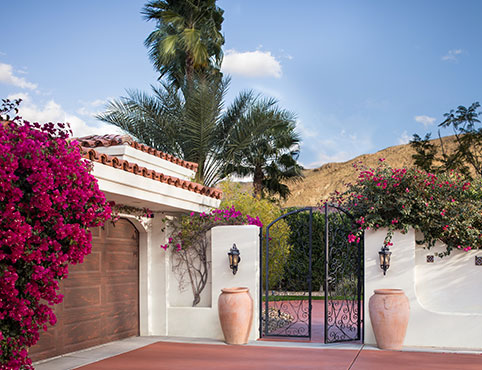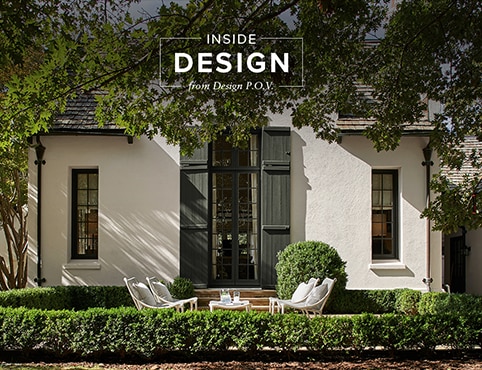Creating a Sense of Place Through Design
A Conversation with Matthew Patrick SmythRead What Matthew Patrick Smyth Has to Say:
From his own home, New York-based interior designer Matthew Patrick Smyth shares his journey on finding a particular house in Connecticut and his insights on designing with a sense of place.
“When I found my house, about five years ago, it’s a 1970s house and wasn't something I was looking for, I just stumbled upon it. What I was taken with was the sense of place, where it was located. The geography, the mountains, the woods. So when I started designing the house, I had to take all that into consideration, what it was going to be like to live here for four seasons.”
“This past year has been amazing, watching things change and evolve. I wanted to be very careful that whatever looked good in the summer, felt comfortable in the winter,” Says Smyth. “And I do this with clients, with a beach house for instance. If they go there all year round, I want to make sure that it's just not a summer house. That when the leaves fall and when it gets cold and it's snowing out, that it also feels as warm and comfortable as it does in the summertime. So I'm very careful about how it reacts to all the seasons and the light because everything changes.”
Smyth shares that he has clients all over the world and every project is different. Every client is different, every location is different. With that, he strives to bring unique qualities to each one; where they are located and how they live plays a big factor in how he designs the space. He calls out that “there are cultural differences in different locations, different countries. For me, that’s the fun part of the process, trying to figure out what's the best solution for this location and this environment. And I take a lot of time to figure out where they are, and how they want to live.”
“And when I focus on a sense of place, even in a New York apartment, I'm very much aware of what the experience of going home is. Traveling through New York, on the city streets and then walking into a client’s home, I try not to blend in what New York is about, but I do take into consideration that we're in New York City or we're in Los Angeles or we're in Paris. London is different from Paris. Light is different in Paris.”
According to Smyth, he is always taking various elements of what he’s seen and experienced. “I try to spend time in those environments and capture the essence. I remember working on a project while I was in New York and the project was in San Francisco. And the colors in New York looked great, and then I got them out to San Francisco and the light coming off the Bay was so different.”
“So everything comes into consideration. You have to balance so many different elements when you're designing a home and take into account the location, the geography, the light.”
“Whenever I get a chance, I take off someplace and I always encourage designers to travel and see what the world is like, because it influences everything you do. You start subconsciously picking up cultural trends and traditions that you can bring to every client and various projects. If I know I'm working in Geneva or Sardinia, or Paris or London or New York, or upstate New York, I try to spend some time there and take in what makes each area so unique, and how can I incorporate this into the home.”
“If the area is new and there's a new city that I want to work in, I try to drive around. I take in the local architecture, I read up about the history of the area, just exploring the territory. After a while that experience, along with doing this for many years on locations, really influences how I work.”
On his own home, Smyth shares “I don't know why I picked this house, and everybody said I was crazy for doing it. But I saw the potential and it just needed to be organized. It needed to be reorganized, cleaned up and made appropriate for today's living. It was built in the mid-seventies, it was for a famous airline pilot, famous to this area, a very beloved airline pilot. So, it was sort of a ‘Playboy’ place when I bought it. And I've always wanted to take a 1970s ranch house and do something with it. So I thought the worst scenario is if I don't like it when I'm finished, I'll sell it and stay where I am. I was in a 1790s house before. So it was a very different experience.”
“I had to rework some of the rooms, reinterpret what was done originally, while still keeping the architecture, which was very strong. The lines were very strong, which is part of why I was attracted to the house.”
“Overall it was a great project and I've just spent a lot of time here this past year. And I've appreciated it even more. I've appreciated how things change and I've watched four seasons come and go. In the past I would get up here on a Friday night, leave Sunday night, it's not the same thing. So I have a greater appreciation for where I am now. I've spent a lot of time here and I look forward to every day in this place.”
Working with Architects and Clients to Create a Vision
Smyth discusses his approach to design when first meeting a new client and starting on a new project, dubbing it “the domino effect of design. It starts at the front door. The landscaping surrounds it. It creates the envelope. That's the first and last thing you see when you visit a house. So it's really important to concentrate on what the whole package is, and not just isolate yourself in smaller rooms and micromanage each of them. It's all a big picture. It's all a part of the process. The living room leads to the outside area. The kitchen goes out to the terraces. You look out the windows, you have to take everything into consideration.”
Smyth further shares that he loves working with architects and “I love working with landscape designers. I love working with professionals in general. A landscape designer can just transform. And as an interior designer, you're like a director of a movie. You're just bringing in all the sources. You have to bring the best people together and you have to let them do what they do best. With landscape designers, this is what they do. I don't micromanage them. They know what they're doing. They know what the landscape's supposed to be like. And I've worked with great professionals and it's made a world of difference.”
“Having now spent a lot of time in my house, I've realized, on the outside, how many spots there were to develop and cultivate and needed more time working on them. I put a deck out in the back to overlook the horse farm. I didn't have that before. I put a vegetable garden in, which I didn't have before. It gave me time to really think about how I wanted to use my property and max out the views, max out my downtime with the space. And it wasn't just about the interiors, it was about finding spots around the landscape that I can enjoy.”
One of the hardest things when you're designing a home is trying to decide what you want, from the color scheme to the architecture. For his own house, Smyth knew he wanted something simple. “I just wanted two or three colors. I'd have a wall color. The trim is all done because it was very strong, like the beams, it is a very strong architectural statement going on and I wanted to emphasize that. So it seems like it's a very neutral scheme. I have a lot of open glass looking onto the mountains and the colors outside, whether it's snow or fall leaves or summer shade. I felt like the architecture led me to the colors.
“So the walls, I kept Benjamin Moore’s Simply White and Benjamin Moore’s White Dove on the trim. But all the beams are Benjamin Moore's Notre Dame, which is my favorite. I've used it quite a bit for clients. It's a wonderful color that is sort of... some people see green in it, some see brown, some people see black, it changes with the light. And I didn't realize how much I used it until I looked at my book and I realized this is in several projects, this color. So obviously it’s my favorite color.”
“Even when I'm working in places that seem to have just a limited season change, there are changes,” says Smyth. “There are changes in the light, in the winter and the summer, temperature changes that affect your mood and how you live in your home, whether you're indoors more often or not. And it could be very subtle, but it's there. And even holidays change everything, your mood changes. So you have to cross all seasons, even if it's very subtle. Even if it feels like there's not a change, there is.”
“I tell students that when you're an interior designer, you're in Nantucket in the winter and Florida in the summer, because the clients have to be there in the good season. So get used to Palm Springs and 110 degree temperatures in August.”
Lastly, Smyth differentiates between projects. “Doing a gut renovation and building a new house are two different approaches. When you do a gut renovation, you have your boundaries usually, that you have to work with. With a brand new home, it's very important to bring in the right people. You want to bring in the right architect, the right contractor, the right window people, and landscapers. And that's a good starting point to get everything right, because you want to site your house perfectly. You want to make sure that you're maximizing the views and the light. And it gives you a chance to just perfect the whole process of building.”

Regional Color Palettes
Explore color palettes from the Southwest, Southeast, Pacific Northwest and the Rocky Mountain regions of the United States.

Matthew Patrick Smyth Inc.
"When I narrow down how a space should develop, it starts with color."

Inside Design
Explore distinct design topics from the interior designers featured on this page.